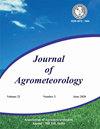环境空气质量与热不适的协同作用:埃及大开罗地区案例研究
Q3 Agricultural and Biological Sciences
引用次数: 0
摘要
热不适与空气污染之间的相互作用给人类健康和环境福祉带来了重大挑战。当空气污染严重时,空气中的热量会滞留在大气中,从而加剧热不适感。本文旨在研究干旱大城市在不同天气情况下的这种相互作用。本文利用天气数据和空气污染来评估三个不同地点(卡哈市、纳赛尔市和十月六日市)的空气质量、热不适水平、它们的影响以及它们之间的关系。环境空气质量是通过测量颗粒物(PM10)、二氧化氮(NO2)和二氧化硫(SO2)的水平来确定的。工作包括对每个城市的不适指数(DI)和空气质量指数(AQI)及其与天气的联系进行统计分析。空气质量评估结果显示,卡哈市相当一部分人口经常感到不适,并暴露在不健康的空气污染水平之下。结果表明,这三个城市的大多数居民至少在某些时候会有不同程度的不适感。在卡哈市,28.97% 的人没有任何不适感,而 25.41% 的人有严重的压力感。在纳斯尔市,32.15% 的人没有不适感,20.21% 的人有严重压力感。在十月六日市,33.76%的人没有不适感,16.65%的人有严重压力感。注意到某些月份,特别是 6 月至 9 月,不适感程度较高,影响到 50%以上的人口。不适感的季节性变化可能是由一系列因素造成的,包括天气、气候和环境条件。不适感的时间变化反映了人们在从寒冷季节向炎热季节过渡时所面临的挑战。本文章由计算机程序翻译,如有差异,请以英文原文为准。
The synergy of ambient air quality and thermal discomfort: A case study of Greater Cairo, Egypt
The interaction between thermal discomfort and air pollution poses significant challenges for human health and environmental well-being. When there is a high level of air pollution, it can worsen thermal discomfort by trapping heat in the atmosphere. This paper aims to study this interaction in arid megacities during different weather events. Weather data and air pollution were utilized to evaluate air quality, thermal discomfort levels, their impact, and their relationship at three separate sites (Qaha, Naser City, and 6th of October City). The ambient air quality is determined by measuring the levels of particulate matter (PM10), nitrogen dioxide (NO2), and sulfur dioxide (SO2). The work included a statistical analysis of the discomfort index (DI) and the air quality index (AQI) for each city and their linkage with the weather. The air quality evaluation revealed that a significant portion of the population in Qaha frequently experienced discomfort and were exposed to unhealthy levels of air pollution. The results show that most of the population in all three cities experience discomfort at least some of the time with varying degrees. In Qaha, 28.97% of the population experiences no discomfort, while 25.41% experiences severe stress. In Nasr City, 32.15% of the population experiences no discomfort, while 20.21% experiences severe stress. The 6th of October City, 33.76% of the population experienced no discomfort, while 16.65% experienced severe stress. Noted that certain months, specifically June to September, are associated with higher levels of discomfort, affecting more than 50% of the population. Seasonal variations in discomfort can be due to a range of factors, including weather, climate, and environmental conditions. The temporal variation in discomfort reflects the challenges people face when transitioning from colder to hotter seasons.
求助全文
通过发布文献求助,成功后即可免费获取论文全文。
去求助
来源期刊

Journal of Agrometeorology
农林科学-农艺学
CiteScore
1.40
自引率
0.00%
发文量
95
审稿时长
>12 weeks
期刊介绍:
The Journal of Agrometeorology (ISSN 0972-1665) , is a quarterly publication of Association of Agrometeorologists appearing in March, June, September and December. Since its beginning in 1999 till 2016, it was a half yearly publication appearing in June and December. In addition to regular issues, Association also brings out the special issues of the journal covering selected papers presented in seminar symposia organized by the Association.
 求助内容:
求助内容: 应助结果提醒方式:
应助结果提醒方式:


